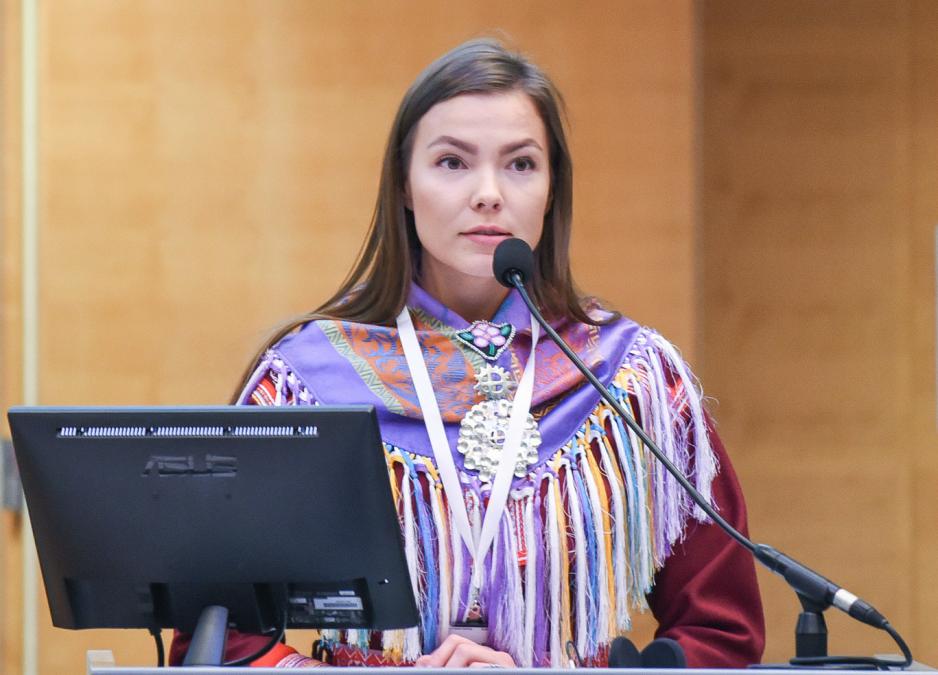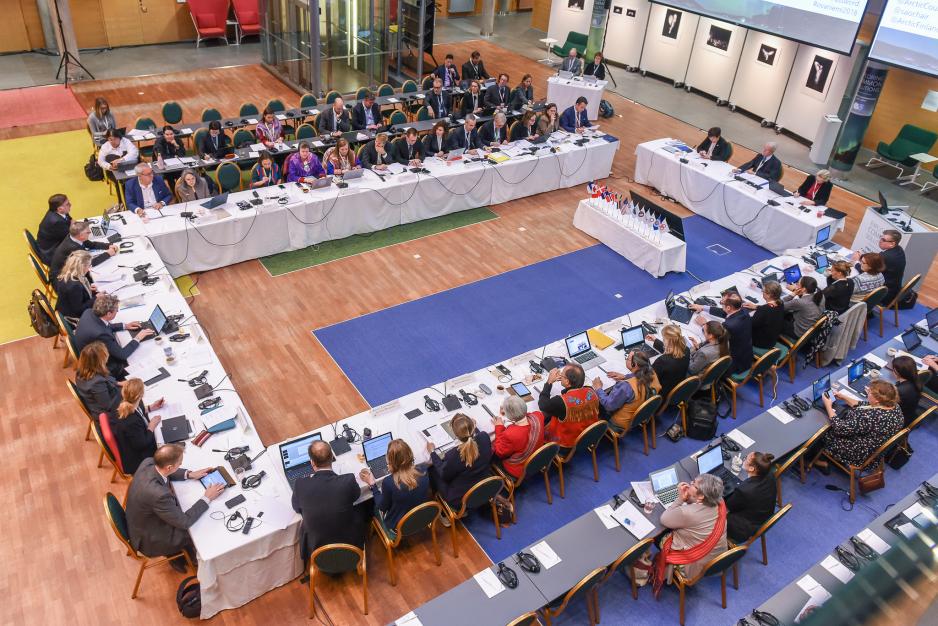Arctic Council Agenda Highlights Biodiversity

Saami Council delegate Rosa-Marén Magga welcomes representatives to Rovaniemi. (Photo: Arctic Council Secretariat/ Linnea Nordström)
Officials and delegates of the Arctic Council concluded a series of meetings this week hosted by the University of Lapland in Rovaniemi, Finland to discuss the progress of work under the Finnish Chairmanship.
The Senior Arctic Official (SAO) meeting was held November 1-2; delegates for the Sustainable Development Working Group (SDWG) met in a separate meeting beforehand on October 29-30, and a Model Arctic Council was also held during the week.
The meetings brought together representatives from the Arctic Council’s eight Arctic Member States and six Permanent Participants, as well as all six Working Groups, two of its Task Forces, one Expert Group, and over 30 Observer states and organizations.
SAO meetings take place about every six months between ministerial meetings; this was the third and penultimate of such meetings under the Finnish Chairmanship. Under its chairmanship program, entitled “Exploring Common Solutions,” Finland has chosen environmental protection, connectivity, meteorological cooperation, and education as its priority areas to focus on.
Agenda highlights biodiversity
During the SAO meeting, representatives were briefed on the progress of projects currently underway. In addition to hearing presentations from the six working groups, officials and delegates received reports from experts representing organizations including the Arctic Resilience Forum and the UArctic Congress.
However, following from the Arctic Biodiversity Assessment (ABA), an eight-year action plan initiated in 2013 under the Conservation of Arctic Flora and Fauna (CAFF) Working Group, the theme that the discussions focused on was Arctic biodiversity. Representatives from all six Arctic Council working groups reported on their efforts in three areas: conservation efforts for biodiversity, the informing of policy, and public engagement. Observers also informed the SAOs on their efforts to promote Arctic biodiversity.
While CAFF noted that considerable progress had been made towards the implementation of many of the ABA’s suggestions, there is still much work to be done to conserve biodiversity in the Arctic. While pollution and overharvest are harming some species, the ABA said that by far, climate change is the single factor most responsible for decline in biodiversity. On the other hand, noting that sound management practices have helped species impacted by overharvest rebound in most cases, the ABA also said that with the right types of intervention, the loss of biodiversity currently underway in the Arctic could be mitigated.

The Senior Arctic Officials of the Arctic Council met from November 1-2, 2018 in Rovaniemi, Finland. (Photo: Arctic Council Secretariat/ Linnea Nordström)
Cooperation and connectivity
In alignment with one of Finland’s priorities, connectivity, the briefing that the Arctic Economic Council (AEC) gave at the meeting underscored its importance. Chair of the Senior Arctic Officials Ambassador Aleksi Härkönen noted that “everyone agreed that connectivity is an ongoing priority,” mentioning further that the Arctic Council is very interested in cooperating more with them on this in the future.
The Arctic Council already has a task force devoted specifically to connectivity issues. Continuing the work of an earlier task force, the Task Force on Telecommunications Infrastructure in the Arctic (TFTIA), the Task Force on Improved Connectivity (TFICA) began its work in November of last year.
Under its mandate, broadly speaking, the TFICA is meant to identify where and what types of telecommunications needs exist in the Arctic, and how to improve telecommunication capacity through current and forthcoming technologies and investments. The AEC has a Connectivity Working Group of its own.
Identifying emerging Arctic issues
The SAOs also discussed a problem that has begun to leave its impact in the Arctic: wildfires. Describing it as an “emerging theme” that cut across conversations during the meeting, Ambassador Härkönen said that the Arctic Council is considering addressing it, although he did not offer a timeline.
With wildfires linked to climate change becoming more prevalent across the circumpolar north, especially in the last several years, the issue is expanding to become increasingly international in scope, impacting entire regions in addition to local communities. With it falling squarely under its remit, Härkönen said that the Emergency Prevention, Preparedness, and Response (EPPR) working group could be the one to work most closely with the issue, although other groups might also work on it from the position of their own mandates.
Preparing to pass the torch to Iceland
In the SAO meeting, the Icelandic delegation also outlined its preliminary plan for the approaching Icelandic chairmanship under the heading “Together Towards a Sustainable Arctic.” While the outline is still a work in progress, Ambassador Härkönen said that there is “lots of continuation” between the upcoming chairmanship and the current one.
The chairmanship of the Arctic Council rotates every two years among the eight circumpolar countries, moving from Finland to Iceland in May 2019.
